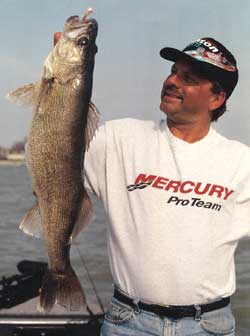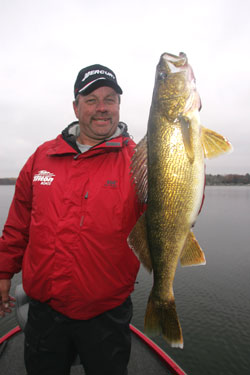 Here in the Midwest, the winter of 2007-08 has pinned us down and beat on us like a schoolyard bully. In many locales, we’ve been punched in the nose by bitterly cold temperatures and pummeled by relentless snowstorms. Every time we’ve gotten to our feet, we’ve been knocked down again.
Here in the Midwest, the winter of 2007-08 has pinned us down and beat on us like a schoolyard bully. In many locales, we’ve been punched in the nose by bitterly cold temperatures and pummeled by relentless snowstorms. Every time we’ve gotten to our feet, we’ve been knocked down again.
Now it’s March, and winter is finally paying for its overbearing behavior. Instead of sleet and snow and sub-zero weather, a growing number of days are embracing us with bright sunshine and warmer temps. It’s one of my favorite times of year because it’s also a period when anglers get to deliver a hard water-open water combination of their own. And no matter which way you go, you are likely to encounter fish that are just as excited about the changing seasons as you are.
This particular March is more promising than most because of the severe winter we’ve been through. Most lakes and river backwaters have thick covers of ice that should last late into March. Meanwhile, the mountains of snow will be slowly melting away and adding flow to our rivers, which in turn will provide more early angling opportunities on those systems. No matter which way you choose to go, there will be plenty of warm days to enjoy those outings. That also makes it a great time of year to include those less adventuresome, fair-weather anglers in your plans.
We hear a great deal about how good early ice can be for species like crappies, bluegills, perch, walleyes and northern pike. It’s hard to beat late ice, too.
In fact, I’ve found panfish species return to many of the same locations they frequented during early ice, such as sloughs, backwaters and shallow bays. You’ll find some giant northern pike in these areas, too, as they follow the forage and eventually spawn. Walleyes often congregate near the mouths of creeks and streams that feed into our lakes and reservoirs.
All of these fish are there to eat, and the gradually warming water triggers a change in their sluggish winter metabolism. Instead of carefully wiggling a waxworm in front of a non-committal perch like you may have done in February, try aggressively working a Jigging Rapala. Rather than trying to entice fussy crappies with minnows or subtle plastics, you can often get them to respond to jigs and spoons.
And instead of relying on tip-ups and live bait to bring walleyes through the hole, go after them with 1/4- or 1/2-ounce jigging spoons.
Your success will also be better because the weather allows you to be more mobile. In fact, there are many days when no tents or heaters are necessary and you can get by with a bucket, an auger, a couple of rods and a flasher that can be easily transported in a small, lightweight sled.
 If river fishing for walleyes is your passion, you can launch the boat or fish from shore below the lock and dam systems in areas that are free of ice.
If river fishing for walleyes is your passion, you can launch the boat or fish from shore below the lock and dam systems in areas that are free of ice.
Because of the possibility of limited open water, floating ice and slippery ramps, I prefer a small boat for these outings. My Triton 1546DS hunting boat powered with a 25 hp Mercury outboard is easy to handle on the ramp and on the water.
Add a MinnKota transom mount trolling motor powered by Optima batteries and you will be set up to slip the current and follow the breaklines and contours that hold walleyes.
These fish won’t spawn until April, but many are already in or near their spawning areas and others will begin arriving every day the flow increases and the water temperatures warm.
My favorite presentation is a simple jig head tipped with a minnow. I use the smallest jig the current will allow, work it slowly and keep it vertical. Add a stinger hook to increase your odds because these fish can be light biters, although there are also days when they will hit your jig like Muhammad Ali.
Your rod and line choice are important to your success. You will need the sensitivity offered by a quality graphite rod. I generally jig with a 6-foot Quantum rod, but I have also used shorter models for a better feel on windy days.
I don’t worry about jig color too much on these early outings. Water clarity is generally good because the runoff from snow and ice is gradual, unlike April when a river system can muddy up in a hurry. Often, a plain leadhead is all I need.
Maybe you can’t decide whether to fish the open water or try your luck through the ice. You may be able to enjoy both angling methods. Toss the basic equipment needed for ice fishing into the boat and split your day between the frozen backwaters and the open channel.
Personally, I’ve had enough sub-zero temperatures and I’ve shoveled enough snow. I’m ready to deliver a one-two punch of my own.










